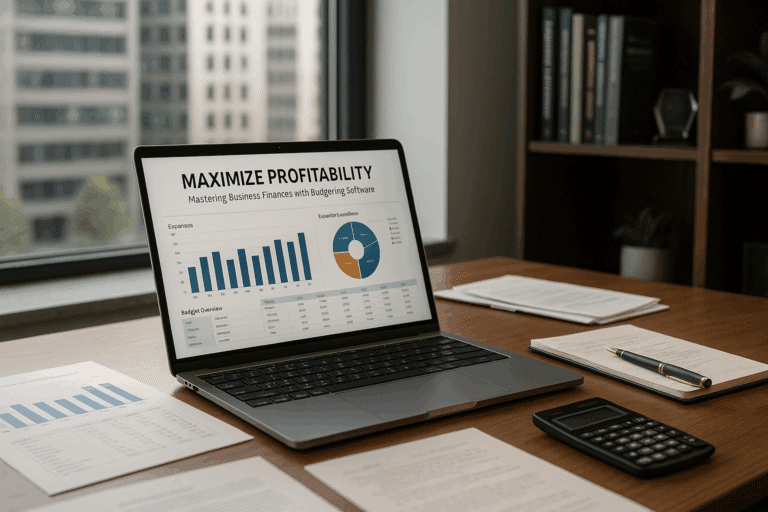This adaptability is powerfully demonstrated in the art and science of budgeting. Welcome to a comprehensive exploration of business budgeting strategies in an ever-changing economic landscape. 🌐💼📈
Business budgeting might be perceived as a mere financial exercise, but in reality, it is a critical business strategy tool. When executed accurately, budgeting serves as a roadmap to success, providing insights into company finances, driving operational efficiency, and enhancing the decision-making process. Given the unpredictable nature of today’s business environment, with changing market trends, customer behavior, and unexpected economic downturns, the process of budgeting has become more challenging yet even more critical. 🔍💰
As we delve deeper into this topic, we will explore the concept of business budgeting, the impacts of economic changes, and most importantly, the strategies to adapt your business budget to thrive amidst these changes. This article is not just for CFOs, financial analysts, or accountants, but for every business leader who understands the immense power of a well-strategized budget. 👩💼👨💼📊
1. The Art of Business Budgeting
Before we delve into the strategies to adapt your budget, it’s crucial to understand the essence of business budgeting. It’s more than just number-crunching or a prerequisite for a fiscal year. It is an art that requires expertise, intuition, and a deep understanding of your business and the industry in which it operates. This understanding helps to predict future trends, anticipate changes, and guide a company towards achieving its objectives.
2. Impacts of Economic Changes on Business Budgeting
Economic conditions are far from being constant. They are influenced by a myriad of factors including political changes, global events, technological advancements, and consumer behavior, amongst others. These changes directly impact business operations, and subsequently, the budgeting process. By understanding these impacts, businesses can be better prepared and can strategically plan their budgets to weather economic uncertainties.
3. Adapting Your Business Budget for Success
Adapting your business budget in the face of changing economic conditions is not a luxury, it’s a necessity. This involves adjusting revenue projections, revisiting capital expenditures, optimizing operational costs, and prioritizing investments that promise the highest return. This section will provide a detailed analysis of how to effectively adapt your budget to align with the changing economic conditions.
This article serves as a guide to empower businesses with the knowledge and strategies needed to effectively adapt their budgets and drive success, regardless of the economic climate. So, get ready to dive into a wealth of knowledge that could potentially transform your approach to business budgeting and set you on a path towards success in any economic landscape. 💪💹
Understanding the Dynamics of Changing Economic Conditions
The ever-evolving landscape of the global economy creates a complex maze that businesses must navigate. To understand these changes, businesses need to delve into the intricacies of economic cycles, market trends, and fiscal policies. If you’re eager to gain a deeper understanding of how economic conditions can impact your business budget, watch the video, “The Economics of Change: How Economic Conditions Impact Businesses” by Economics Explained on YouTube. It provides a comprehensive overview of the ways in which economic variables can influence a company’s financial planning and strategy.
When the economic climate shifts, businesses can find themselves in uncharted territory. Adapting to these changes often requires strategic financial management, effective budgeting, and robust forecasting. By anticipating economic trends and planning accordingly, businesses can maintain stability, even amidst economic uncertainty.
However, understanding and adapting to changing economic conditions isn’t as straightforward as it may seem. It involves a thorough assessment of internal and external factors, meticulous planning, and strategic execution. This article aims to guide you through the process of budgeting for success, despite changing economic conditions.
Strategic Budgeting: Laying the Foundation for Success
A strategic budget serves as the financial blueprint of a business. It outlines the allocation of resources based on forecasted revenues and expenses. This detailed financial plan allows businesses to prioritize their expenditures and investments, ensuring that they align with the company’s objectives and goals.
Given its crucial role in a business’s financial health, the budgeting process should be strategic and adaptive. However, many businesses create their budgets based on historical data and fail to consider potential changes in the economic environment. As a result, their budgets often fall short in the face of economic uncertainties.
To avoid this pitfall, businesses need to adopt a proactive approach to budgeting. This involves closely monitoring economic indicators, performing regular budget reviews, and making necessary adjustments. By doing so, businesses can adapt their budgets to align with changing economic conditions and thrive amidst uncertainties. Check out the video, “Budgeting for Success: Adapting to Changing Economic Conditions” by Financial Times on YouTube for more insights on strategic budgeting.
How to Adapt Your Business Budget to Changing Economic Conditions
Adapting a business budget to changing economic conditions involves several steps. The first is to understand the current economic environment and how it can impact your business. This involves analyzing economic indicators such as inflation rates, interest rates, and gross domestic product (GDP).
Next, assess your business’s current financial position. Review your income statements, balance sheets, and cash flow statements to identify any areas of concern. Consider how changes in the economic environment may affect your revenues, expenses, and cash flows.
Finally, adjust your budget accordingly. If economic conditions are unfavorable, you may need to reduce your expenses or seek alternative sources of income. If conditions are favorable, you may have the opportunity to invest in growth initiatives. Whatever the case, your budget should reflect the realities of the economic environment and your business’s financial capabilities.
Tools and Techniques for Adaptive Budgeting
Adaptive budgeting involves a set of tools and techniques that allow businesses to adjust their budgets based on changing economic conditions. These include variance analysis, flexible budgeting, and rolling forecasts.
Variance analysis involves comparing actual results to budgeted figures. This allows businesses to identify any discrepancies and understand their causes. On the other hand, flexible budgeting involves creating multiple budget scenarios based on different economic conditions. This enables businesses to plan for various possibilities and adapt quickly when circumstances change.
Rolling forecasts, meanwhile, involve regularly updating budget forecasts based on recent performance and anticipated changes in the economic environment. This allows businesses to maintain a forward-looking perspective and make timely adjustments to their budgets.
Together, these tools and techniques can provide businesses with a robust framework for adaptive budgeting. They allow businesses to remain flexible and responsive, enabling them to navigate changing economic conditions successfully.
Comparative Analysis: Traditional Budgeting vs. Adaptive Budgeting
| Aspect | Traditional Budgeting | Adaptive Budgeting |
|---|---|---|
| Flexibility | Low: Budgets are fixed and changes are not easily made. | High: Budgets are flexible and can be adjusted based on changing economic conditions. |
| Forecast Accuracy | Low: Budgets are based on historical data and may not accurately predict future performance. | High: Budgets are based on rolling forecasts and are regularly updated to reflect recent performance and anticipated changes. |
| Responsiveness | Low: Budgets do not easily accommodate changes in the economic environment. | High: Budgets are designed to adapt to changing economic conditions. |
Navigating Changing Economic Conditions: Key Takeaways
Changing economic conditions can pose significant challenges for businesses. However, by adopting a strategic and adaptive approach to budgeting, businesses can navigate these challenges successfully. This involves understanding the current economic environment, assessing the business’s financial position, and adjusting the budget accordingly.
Moreover, businesses can leverage tools and techniques such as variance analysis, flexible budgeting, and rolling forecasts to enhance their budgeting process. By doing so, they can remain flexible and responsive, enabling them to thrive amidst changing economic conditions.
Adapting to changing economic conditions is not an easy task, but with the right approach and tools, it is certainly achievable. If you’re interested in learning more about adaptive budgeting, check out the video, “Adaptive Budgeting: A Key to Financial Success” by Finance Simplified on YouTube. It provides an in-depth explanation of the concept and its benefits.

Conclusion
In conclusion, we have traversed the broad expanse of topics related to the field of software engineering and information technology. This expedition was by no means a trivial matter, as the intricacies and peculiarities of these fields require a depth of understanding that is only achieved through rigorous study and practical experience.
We commenced our journey with a profound exploration of the principles that underpin software engineering. The importance of these principles cannot be overstated. As software engineers, we are responsible for designing and implementing systems that not only function as expected, but also adhere to ethical standards and best practices. Our decisions can have far-reaching consequences, impacting not just the users of our software, but also the wider community.
Following this, we delved into the world of information technology. This arena is fast-paced and ever-evolving, with new advancements and innovations emerging at a breathtaking pace. As IT professionals, we must continually strive to stay abreast of these changes, adapting our skills and knowledge to meet the demands of this dynamic industry.
In our discussion, we also addressed the symbiotic relationship between software engineering and information technology. These two fields are not disparate entities, but rather, they are interwoven threads in the tapestry of digital innovation. Our ability to leverage the strengths of both disciplines is key to navigating the complexities of the technological landscape.
Lastly, we explored some of the challenges and opportunities that lie ahead for software engineers and IT professionals. As we hurtle towards a future that is increasingly driven by technology, our role as innovators and problem-solvers becomes ever more critical. We are the architects of the digital age, and the onus is on us to shape this era in a way that is beneficial for all.
In wrapping up this discourse, I would like to encourage you to reflect on the insights shared in this article, and consider how they might apply to your own professional journey. Whether you are a seasoned software engineer or an aspiring IT professional, there is always more to learn and discover in this fascinating field.
As always, I am eager to hear your thoughts and perspectives on the topics discussed. Feel free to leave a comment below, or share this article with your colleagues and peers.
I would like to express my gratitude for your time and attention. I trust that this exploration has been enlightening, and I hope it has inspired you to continue delving deeper into the world of software engineering and information technology.
Until our next expedition, keep coding, keep exploring, and most importantly, keep learning. 🔍👨💻💡
For further reading, I would recommend the following resources:
1. W3Schools – A comprehensive resource for learning web technologies online.
2. Stack Overflow – A platform for developers to learn and share their knowledge.
3. Codecademy – An online interactive platform that offers free coding classes in various programming languages.
4. Geeks for Geeks – A computer science portal for geeks.
These resources offer a wealth of information that can aid in your ongoing quest for knowledge in the realms of software engineering and information technology.
Remember, in this rapidly evolving digital age, the key to success is continuous learning and adaptation.
Keep striving, keep innovating, and keep pushing the boundaries of what is possible. 🚀
References:
[1] “Principles of Software Engineering”, IEEE Xplore
[2] “Information Technology: An Overview”, Science Direct



